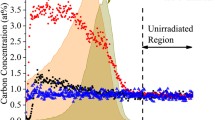Abstract
Space Shuttle orbiter thrusters fabricated from C-103 niobium alloy rely on a fused chromium disilicide coating as protection from high-temperature oxidation. Coating voids caused by high-temperature spalling, micrometeorite damage, or other impact damage must first be detected, and then characterized to measure the amount of remaining coating materials, since service life is directly proportional to coating thickness. Existing techniques to estimate the thickness of this diffusion layer are labor intensive, prone to error, and require contact with the coating. Alternative non-contact methods are sought that can automate the detection and characterization of coating defects.
Micro X-ray fluorescence (MXRF) imaging is evaluated in this study as a potential NDE method to inspect the chromium disilicide coating. MXRF imaging, a relatively new technique to map the elemental composition of a surface, creates a high spatial resolution multispectral image that can be analyzed to detect coating voids and to quantify the remaining coating materials diffused in the alloy. Analysis of image data collected from sectioned thruster samples confirms that MXRF imaging is a viable detection and characterization method for the thruster coating inspection problem.
Similar content being viewed by others
REFERENCES
C-103 Data Sheet Literature, Wah Chang Company, 2003, Albany, OR. Available at: http://www.alleghenytechnologies.com.
S. Priceman, Private Communication, May 2003, Hitemco, Old Bethpage, New York.
K. Ogawa, D. Minkov, T. Shoji, M. Sata, and H. Hashimoto, “NDE of degradation of thermal barrier coating by means of impedance spectroscopy,” NDT&E Int. 32, pp. 177–185 (1999).
R. J. Christensen, D. M. Lipkin, D. R. Clarke, and K. Murphy, “Nondestructive evaluation of the oxidation stresses through thermal barrier coatings using Cr 3+ piezospectrocopy,” Appl. Phys. Lett. 69(24), pp. 3745–3756 (1996).
H. P. Crutzen, F. Lakestani, and J. R. Nicholls, “Ultrasonic characterization of thermal barrier coatings,” Proc. IEEE Ultras. Symp., pp. 731–734 (1996).
M. K. Tiwari, A. K. Singh, and K. J. S. Sawhney, “Analysis of stainless steel samples by energy dispersive X-ray fluorescence (EDXRF) spectrometry,” Bull. Mater. Sci. 24(6), pp. 633–638 (2001).
P. Wobrauschek, G. Halmetschlager, S. Zamini, C. Jokubonis, G. Trnka, and M. Karwowski, “Energy-dispersive X-ray fluorescence analysis of Celtic glasses,” X-Ray Spectrom. 29, pp. 25–33 (2000).
R. Wilson, G. Hamill, M. Funahashi, M. Kuraoka, S. Fujimura, and H. Kohno, “Comprehensive characterization of thin films using X-ray reflectometry and fluorescence,” Materials Research Society Fall Meeting Conference Proceedings, Nov. 30–Dec. 4, Boston, MA (1998).
C. G. Worley, G. J. Havrilla, and P. S. Dunn, “Quantification of large scale micro-x-ray fluorescence elemental images,” Appl. Spectrosc. 55(11), pp. 1448–1454 (2001).
M.L. Hoppe, D. Harding, and R. B. Stephens, “Characterization of chemical dopants in ICF targets,” General Atomics Report GA-A22485, 1996, General Atomics, San Diego, CA.
G. J. Havrilla, “Applications of X-ray microfluorescence to materials analysis,” X-Ray Spectrom. 26(6), pp. 364–373 (1997).
N. Gao, I. Yu. Ponomarev, Q. F. Xiao, W. M. Gibson, and D. A. Carpenter, “Monolithic polycapillary focusing optics and their applications in microbeam X-ray fluorescence,” Appl. Phys. Lett. 69(11), pp. 1529–1531 (1996).
C. G. Worley and G. J. Havrilla, “Micro-X-ray fluorescence characterization of mixed oxide fuel surrogate feed material,” Anal. Chem. 70(14), pp. 2957–2963 (1998).
J. R. Schoonover, F. Weesner, G. J. Havrilla, M. Sparrow, and P. Treado, “Integration of elemental and molecular imaging to characterize heteogeneous inorganic materials,” Appl. Spectrosc. 52(12), pp. 1505–1514 (1998).
J. R. Schoonover and G. J. Havrilla, “Combining X-ray fluorescence spectrometry and vibrational microscopy to assess highly heterogeneous, actinide-contaminated materials,” Appl. Spectrosc. 53(3), pp. 257–265 (1999).
S. Bichlmeier, K. Janssens, J. Heckel, D. Gibson, P. Hoffmann, and H. M. Ortner, “Component selection for a compact micro-XRF spectrometer,” X-Ray Spectrom. 30, pp. 8–14 (2001).
E. P. Bertin, Introduction to X-Ray Spectrometric Analysis, p. 351, 1978, Plenum Press, New York, NY.
E. P. Bertin, Introduction to X-ray Spectrometric Analysis, p. 45, 1978, Plenum Press, New York, NY.
E. P. Bertin, Introduction to X-Ray Spectrometric Analysis, p. 44, 1978, Plenum Press, New York, NY.
C. T. Chantler, K. Olsen, R. A. Dragoset, A. R. Kishore, S. A. Kotochigova, and D. S. Zucker, X-Ray Form Factor, Attenuation and Scattering Tables, Version 2.0, National Institute of Standards and Technology, Gaithersburg, MD, 2003. Available at http://physics.nist.gov/ffast.
A. C. Thompson and D. Vaughan, editors, X-Ray Data Booklet, 2nd ed., 2001, Lawrence Berkeley National Laboratory, University of California, Berkeley, CA.
A. Seaman, Analysis Depth for µ-EDXRF Methods, EDAX Eagle-II µ-Probe Application Note, EDAX, Inc., Mahwa, NJ, 2000.
B. McLemore, Private Communication (May 2003), Spin Forge, El Segundo, CA.
P. Thevenaz, “Turbo Registration” plugin for ImageJ software, 2003, Swiss Federal Institute of Technology, Lausanne, Switzerland. Available at: http://bigwww.epfl.ch/thevenaz/ turboreg.
Author information
Authors and Affiliations
Rights and permissions
About this article
Cite this article
Doering, E.R., Havrilla, G.J. & Miller, T.C. Disilicide Diffusion Coating Inspection by Micro X-Ray Fluorescence Imaging. Journal of Nondestructive Evaluation 23, 95–105 (2004). https://doi.org/10.1023/B:JONE.0000048865.96417.bc
Issue Date:
DOI: https://doi.org/10.1023/B:JONE.0000048865.96417.bc




